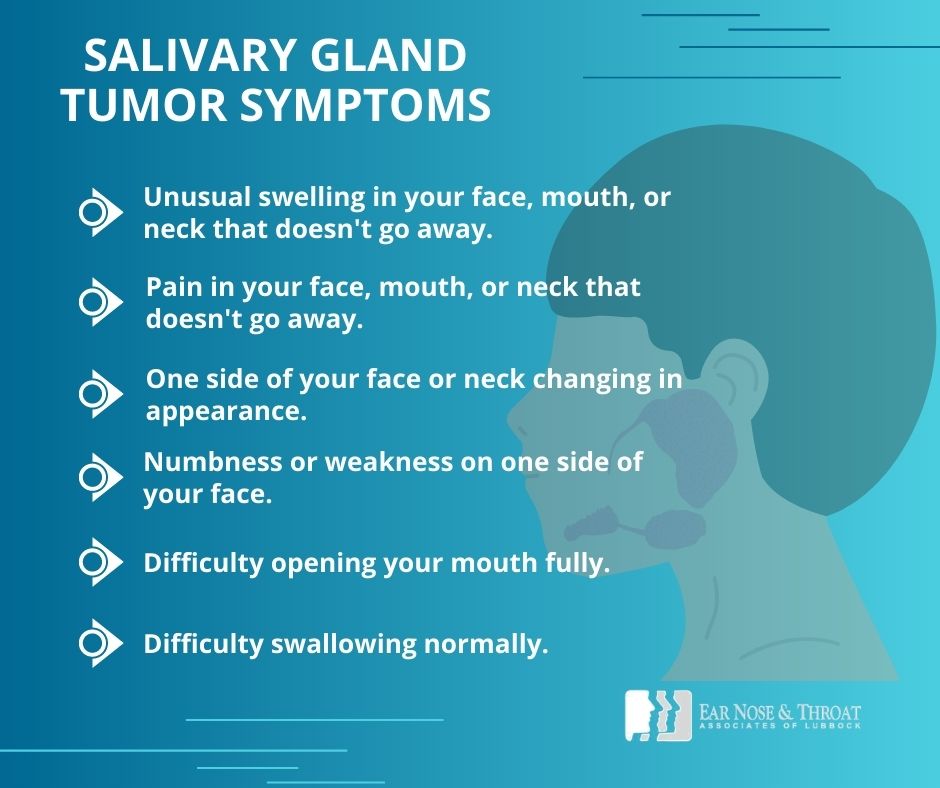Salivary Gland Tumors Symptoms and When To Call Your Doctor

“Tumor” is a scary word. We associate tumors with cancer, and then cancer with shortened lifespans.
But fortunately, tumors don’t always mean cancer.
If something unusual is going on with your salivary glands, you may be worried about a salivary gland tumor. Here, we’ll take a look at some common salivary gland tumor symptoms, along with who’s at risk for this specific kind of tumor.
What Are Salivary Gland Tumors?
Salivary gland tumors are unusual growths that can form in the salivary glands or the ducts leading out of the salivary glands. The job of the salivary glands is to produce saliva to help maintain oral health, moisten the mouth, and begin the breakdown of food.
Besides the many minor salivary glands scattered throughout the mouth, people have three pairs of major salivary glands:
- Parotid salivary glands directly in front of the ears.
- Submandibular salivary glands below the border of the jaw.
- Sublingual salivary glands underneath the tongue.
Tumors can occur in any of these major salivary glands. But the vast majority of salivary gland tumors (about 80%) form in the parotid glands.
Not many people develop salivary gland tumors. But even if you do, odds are in your favor for it not being cancerous. About 75% of parotid gland tumors are benign, and 50% of submandibular gland tumors are benign. Sublingual gland tumors are more likely to be cancerous, but these are extremely rare.
Salivary Gland Tumor Symptoms
Salivary gland tumor symptoms can be a bit tricky to spot because the symptoms don’t appear immediately. The tumors tend to grow slowly, which means they may not be large enough to cause symptoms for some time.
The most common salivary gland tumor symptom is a small lump in front of the ear, near the jaw, or in the neck. Patients usually can’t feel this lump until the tumor grows to at least 1 centimeter (cm) in diameter. Once it grows to 2 cm or larger, patients may be able to see a bump when they look in the mirror. A doctor may notice less visible lumps when palpating a patient’s neck or jaw during a routine exam.
Salivary gland tumors can involve the nerves, muscles, and other structures in the face, so they can sometimes interfere with the normal functioning of those structures. As such, other salivary gland tumor symptoms to watch for include:
- Unusual swelling in your face, mouth, or neck that doesn’t go away.
- Pain in your face, mouth, or neck that doesn’t go away.
- One side of your face or neck changing in appearance.
- Numbness or weakness on one side of your face.
- Difficulty opening your mouth fully.
- Difficulty swallowing normally.

Who’s at Risk for Salivary Gland Tumors?
Many times, tumors, cancers, and abnormal growths can be linked to genetics, lifestyle choices, and other clear causes. Unfortunately, researchers have yet to find a clear link between most salivary gland tumors and any clear cause.
Warthin tumors, a specific type of salivary gland tumor, have been linked to smoking. But possible causes for other types of salivary gland tumors are less clear.
About two out of three cancerous salivary gland tumors are diagnosed in adults older than 55, meaning (as with many cancers) age may be a risk factor.
Exposure to radiation and certain workplace substances, such as sawdust, pesticides, and industrial solvents, may also increase people’s risk for developing specific salivary gland cancers.
How Common Are Salivary Gland Tumors?
Salivary gland tumors aren’t very common.
One population-based study concluded that about five people per 100,000 develop a benign salivary gland tumor, and only one develops a cancerous tumor.
The American Cancer Society reports that cancerous salivary gland tumors account for 6–8% of all head and neck cancers. They estimate between 2,000 and 2,500 cases of salivary gland cancer in the U.S. each year.
When To Call a Doctor About Salivary Gland Tumor Symptoms
Although salivary gland tumors are rare, it’s always best to get anything concerning checked out. If you think you might be experiencing salivary gland tumor symptoms, contact your ENT doctor to make an appointment.
While you might be hesitant to call just for an innocuous little lump, some of the other salivary gland tumor symptoms are more concerning and warrant immediate investigation. These include:
- Swelling or pain in your mouth that worsens while eating or chewing.
- A lump in the mouth or neck that grows and/or doesn’t disappear within two to three weeks.
Other concerning symptoms include:
- Pain in the lump.
- An immobile lump.
- A rock-hard lump.
- Facial weakness.
- Facial paralysis.
Most of the time, treatment involves removing all or part of the salivary gland and its accompanying duct. Cancerous tumors may require radiation as well.
The outlook for patients after salivary gland tumor treatment is generally excellent, especially with early detection. Patients can help by paying attention to any salivary gland tumor symptoms they notice and consulting their doctor as soon as possible. The earlier we detect a salivary gland tumor, the earlier we can treat it.
Dr. Scolaro is a board-certified Otolaryngologist servicing the South Plains area. He has been practicing in Lubbock since 1990 and has earned a reputation as a skilled and experienced surgeon. He currently serves as the Medical Director for Covenant High Plains Surgery Center campuses, is a member of Covenant Health Partners and is an adjunct faculty professor for Texas Tech University Health Sciences Center School of Medicine. Learn more about Dr. Scolaro.
Categories:








